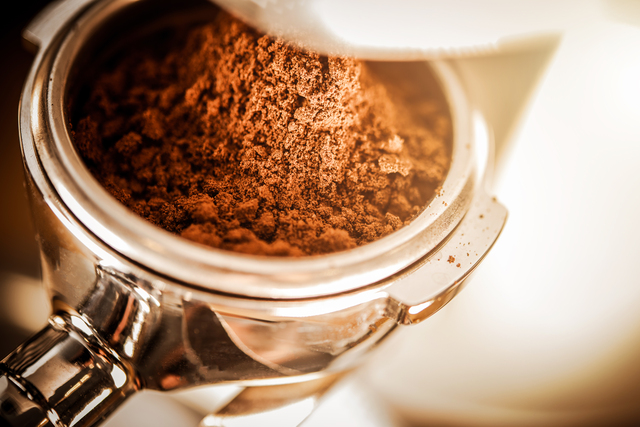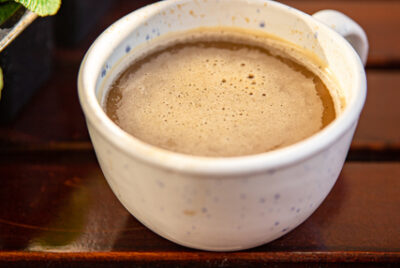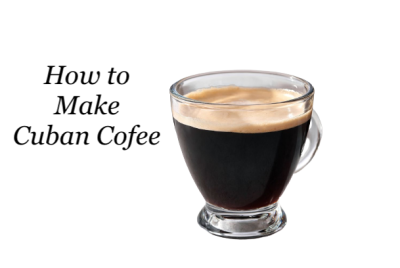How to Grind Coffee Beans: The Definitive Guide
As a coffee enthusiast, learning how to grind coffee beans became an absolute game changer in the taste and quality of my coffee.
I’m often asked, “does grinding coffee beans really make a difference?”
My answer is a resounding “yes!” Grinding coffee beans just before brewing is a key step to unlocking the robust flavors and aromas that make each cup of coffee unique.
How Coffee Grinding Affects Taste
Coffee grinding is a critical step in the brewing process and significantly affects the taste of your final cup of coffee. Here’s why:
1) Surface Area and Extraction:
When you grind coffee, you increase the total surface area of the coffee that comes into contact with the water. The more finely ground the coffee is, the more surface area there is, and the more quickly the coffee can be extracted. Therefore, the size of your grind directly affects the extraction rate of your coffee. Too fine of a grind can lead to over-extraction, resulting in a bitter taste. On the other hand, too coarse of a grind can lead to under-extraction, resulting in a weak or sour taste.
2) Grind Consistency:
The consistency of your grind also plays a big role in the taste of your coffee. If your grind is inconsistent (a mix of large and small particles), you’ll likely get an uneven extraction. Some of the coffee may be over-extracted, while some may be under-extracted, leading to a muddled flavor profile. Using a good quality grinder can help ensure a consistent grind.
3) Freshness:
Coffee beans begin to lose flavor as soon as they’re ground due to exposure to air and moisture. Therefore, grinding your coffee beans right before you brew can help preserve the fresh taste.
To achieve the best flavor, you need to match your grind size to your brewing method. For example, espresso requires a fine grind, while French press coffee works best with a coarse grind. So, understanding your brewing method and how to adjust your grind size to match it is key to brewing a delicious cup of coffee.
The Freshness Factor in Grinding Coffee Beans
Coffee aficionados often emphasize the importance of using freshly ground coffee beans, and for good reason. Coffee beans contain numerous volatile compounds that contribute to their flavor and aroma, and these begin to escape as soon as the beans are ground.
This phenomenon, known as degassing, is why pre-ground coffee can sometimes taste flat compared to coffee made from freshly ground beans. The longer the ground coffee is exposed to air, the more flavor it loses.
Coffee beans also contain oils that are crucial to the flavor of the coffee. When the beans are ground, these oils are exposed to air and can become rancid over time, negatively impacting the flavor of your brew.
Grinding coffee beans at home right before brewing ensures that these flavorful compounds and oils are preserved, giving you the freshest, most flavorful coffee possible.
Moreover, freshly ground coffee beans also allow for a better extraction process. When water is poured over the grounds, it can more easily extract the flavors from fresh grounds compared to stale ones.
Types of Coffee Grinders
Choosing the right coffee grinder is an important step in crafting the perfect cup of coffee. There are two primary types of coffee grinders available: blade grinders and burr grinders.
Each of these grinder types has its advantages and disadvantages, and they can produce quite different results.
Blade Grinders
A blade grinder uses a set of rotating blades to chop coffee beans into smaller pieces. You control the grind size by how long you let the grinder run. The longer you grind, the finer the coffee particles.
While blade grinders are generally more affordable than burr grinders, they do have a few downsides. The main issue is the inconsistency of the grind. Because the blades chop the beans randomly, you can end up with a mix of big and small particles (also known as ‘boulders’ and ‘fines’). This inconsistency can lead to uneven extraction when you brew your coffee, which may affect the taste.
Burr Grinders
A burr grinder, on the other hand, has two abrasive surfaces (burrs) that the coffee passes through for grinding. The distance between these burrs determines the size of the coffee particles.
Burr grinders are prized for their consistency. They grind coffee beans to uniform particle sizes, which leads to even extraction and a balanced flavor. They also allow you to easily adjust the grind size, so you can switch between making espresso (fine grind) to French press coffee (coarse grind) with ease.
The main downside of burr grinders is that they are generally more expensive than blade grinders. However, many coffee enthusiasts would argue that the improved taste of your coffee is well worth the investment.
Manual vs. Electric Grinders
Both blade and burr grinders can come in manual and electric versions. Manual grinders require some elbow grease, but they’re quiet, portable, and often cheaper than their electric counterparts. They’re a popular choice for people who like to make coffee when they’re out camping or traveling.
Electric grinders, meanwhile, do the work for you with the touch of a button. They’re fast and easy to use, which can be a big advantage when you’re making coffee for a crowd or in a hurry in the morning.
The type of grinder you choose will depend on your budget, your coffee preferences, and how much effort you’re willing to put into grinding your beans. But whether you choose a blade or burr, manual or electric, grinding your own coffee beans can take your coffee to the next level.
Choosing Your Grind Size
Choosing the right grind size is critical to achieving the perfect cup of coffee. The size of your coffee grounds can have a significant impact on the taste and strength of your brew. Each brewing method requires a different grind size for optimal extraction. But, how do you know what grind size to use for your coffee?
Well, let’s dive into the specifics!
Understanding Coffee Extraction
To understand why grind size matters, it’s important to first grasp the concept of coffee extraction. When you add hot water to coffee grounds, it extracts the flavors from the grounds. The size of the coffee particles affects how quickly this extraction occurs.
Smaller particles have a larger surface area relative to their volume, which allows for quicker extraction. So, fine grinds can lead to stronger, more full-bodied coffee. However, if you extract too much, the coffee can become bitter.
Conversely, larger coffee particles have a smaller surface area relative to their volume. This slows the extraction process, producing a milder flavor. But, if you extract too little, the coffee can taste sour or underdeveloped.
Matching Grind Size to Brewing Method
Different brewing methods require different contact times between the water and the coffee. So, you need to adjust your grind size based on the brewing method you’re using to ensure proper extraction. Here’s a rough guide:
-Extra Coarse: This grind is similar in size to peppercorns and is best for cold brew coffee and cowboy coffee.
-Coarse: Coarse grinds resemble sea salt and are perfect for French press and percolator coffee.
-Medium-Coarse: If you’re using a Chemex, this grind size, which looks like rough sand, is ideal.
-Medium: A medium grind is about the consistency of regular sand and works well for drip coffee makers and siphon coffee.
-Medium-Fine: This grind is slightly finer than sand and is great for pour-over cones and vacuum pots.
-Fine: A fine grind is a little finer than table salt and is used for espresso and AeroPress (with a 2-3 minute brew time).
-Extra Fine: This grind is even finer than sugar and is used for Turkish coffee.
Remember, these are general guidelines, and you may need to adjust your grind size based on your personal taste and specific equipment.
Adjusting Grind Size Based on Taste
If you’re not happy with the taste of your coffee, adjusting your grind size might help. If the taste is too bitter, try a coarser grind. When the taste is too sour or weak, a finer grind might be the solution. The key is to experiment and adjust until you find what tastes best to you.
Step-by-Step Guide to Grinding Coffee Beans
Once you understand the importance of grinding coffee beans and have a coffee grinder on hand, the next step is to actually grind the beans.
Here is a step-by-step guide on how to effectively grind your coffee beans:
1. Measure Your Coffee Beans
First things first, you need to determine how much coffee you want to make and measure out the beans. A good starting point is to use a 1:15 coffee-to-water ratio. That means for every 1 gram of coffee, you’ll need 15 grams (or milliliters) of water. So, if you’re brewing a single cup of coffee (about 250 milliliters), you’ll need approximately 17 grams of coffee beans.
2. Choose the Right Grind Size
As discussed earlier, the grind size you choose should match your brewing method. Choose the appropriate grind size for your brewing method, and remember, you can adjust this over time if your coffee doesn’t taste quite right.
3. Get Your Grinder Ready
For a burr grinder, fill the hopper with your measured coffee beans. Make sure the grinder is set to your desired grind size. For a blade grinder, pour the beans into the grinder, but be aware that achieving a consistent grind size will be harder with this type of grinder.
4. Grind the Coffee
For a burr grinder, simply turn on the grinder and wait until all the beans have passed through the burrs. For a blade grinder, you’ll have to pulse the grinder and shake it intermittently to get a more uniform grind. Be careful not to overheat the beans as this can negatively impact the flavor.
5. Check the Consistency
Once your coffee is ground, check to make sure the grind size looks consistent. If you find that the grounds are not uniform or don’t match your desired grind size, adjust your grinder settings or your technique and try again.
6. Brew Your Coffee
Now that your coffee is ground, it’s time to brew! Remember, it’s best to brew your coffee immediately after grinding the beans to get the most flavor out of your coffee.
By following these steps, you can start to grind your own coffee beans at home and enjoy the fresh and full flavors that come from freshly ground coffee. It might take a little experimentation and practice, but the end result will be well worth it. Happy brewing!
Troubleshooting Common Grinding Issues
Even with the best of intentions and careful attention to detail, you may encounter some issues when grinding coffee beans. Here’s a rundown of some common grinding problems and potential solutions:
Inconsistent Grinds
One of the most common problems is an inconsistent grind, where you end up with a mixture of fine and coarse particles. This is especially prevalent with blade grinders. To mitigate this, try pulsing the grinder rather than holding down the button, and shake the grinder in between pulses to redistribute the beans.
If you’re using a burr grinder and still getting inconsistent results, it might be time to clean your grinder. Coffee oils can build up on the burrs over time, leading to inconsistent grinding. Regularly cleaning your grinder with a dry brush or a grinder cleaning product can help maintain its performance.
Coffee Tastes Bitter or Sour
If your coffee tastes off, it could be due to the grind size. A bitter taste can indicate over-extraction, which often occurs when the grind size is too fine and water spends too much time in contact with the coffee. On the other hand, a sour taste can indicate under-extraction, typically resulting from a grind that’s too coarse, causing water to pass through too quickly.
Grinder Is Overheating
If you notice your grinder is getting hot during use, it’s usually a sign of overworking the motor. This is often a problem with blade grinders when trying to achieve a fine grind. Overheating can cause the coffee to taste burnt. To prevent this, grind in short bursts and let the grinder rest in between.
Coffee Doesn’t Taste Fresh
If your coffee doesn’t taste fresh, despite grinding right before brewing, your beans might be the problem. Coffee beans are best used within a month of their roast date. After that, they start losing flavor. Also, ensure your beans are stored in a cool, dark place in an airtight container to maintain their freshness.
Troubleshooting these common grinding issues will help you enhance your coffee’s taste and make your home brewing experience even more enjoyable.
Conclusion
Grinding your own coffee beans isn’t just for coffee connoisseurs—it’s for anyone who appreciates a fresh, flavorful cup of coffee. So why not give it a try? You might be surprised at the difference it makes!
How to Grind Coffee Beans FAQs
Can I use a blender to grind coffee beans?
While it’s possible to use a blender to grind coffee beans, it may not yield the most consistent results. Blenders typically can’t achieve the fine, even grind that you can get from a dedicated coffee grinder. If you decide to use a blender, pulse the beans in short bursts to avoid overheating them.
How long does ground coffee stay fresh?
Ground coffee starts to lose its flavor as soon as it’s exposed to air. For the freshest taste, it’s best to grind your coffee beans just before brewing. If you need to store ground coffee, keep it in an airtight container in a cool, dark place, and try to use it within one to two weeks.
What’s the best way to clean a coffee grinder?
To clean your coffee grinder, start by unplugging it. Then, remove any removable parts and clean them with warm, soapy water. For parts that can’t be removed, use a dry brush to remove any remaining coffee grounds. Be sure to dry all parts thoroughly before reassembling and using the grinder.
Can I adjust the grind size on my coffee grinder?
Yes, most coffee grinders allow you to adjust the grind size. Check your grinder’s manual for instructions on how to do this. Remember, different brewing methods require different grind sizes—for example, a French press requires a coarse grind, while an espresso machine needs a fine grind.
Why does my coffee taste bitter after grinding the beans?
If your coffee tastes bitter, it could be because the grind size is too fine, causing over-extraction during the brewing process. Try using a coarser grind. It could also be that your coffee beans are too darkly roasted for your taste, or the water temperature during brewing was too high. Experimenting with these factors can help you achieve the perfect cup of coffee.
Can I use coffee grounds in plants?
Yes, but it depends on the plant. Coffee grounds can be good for tomato plants and many others. That being said, also check out the list of plants that don’t do well with coffee grounds.




